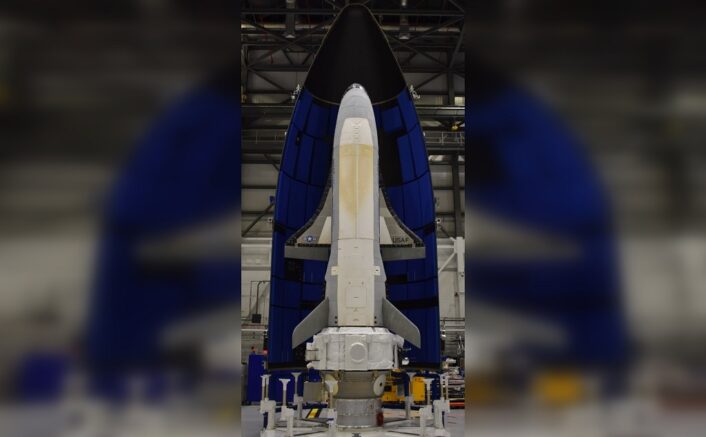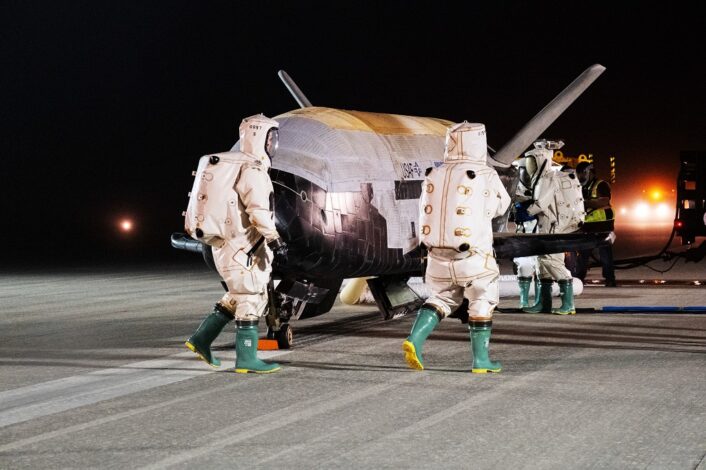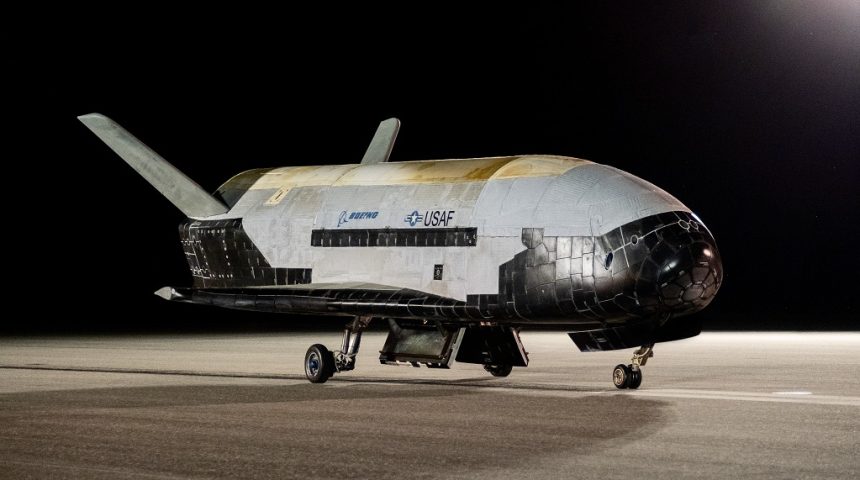The unmanned spaceplane returned to Earth after spending an impressive 908 days in orbit.
The X-37B Orbital Test Vehicle successfully deorbited and landed at NASA’s Kennedy Space Center Shuttle Landing Facility on Nov. 12, 2022, at 05:22 AM LT. The landing was accompanied by sonic booms heard around Florida which, together with a Temporary Flight Restriction over the KSC, started the rumor about the X-37B arrival even before the official announcement by the U.S. Space Force.
The mission, called OTV-6, is the sixth mission overall for the unmanned, reusable spaceplane and the third for the first X-37B. Launched atop a United Launch Alliance Atlas V rocket from Cape Canaveral Space Launch Complex 41 on May 17, 2020, the X-37B spent 908 days in Low Earth Orbit, setting a new endurance record which surpasses its previous record of 780 days on-orbit, established in 2019 at the end of the OTV-5 mission.
The reusable spaceplane was launched on an Atlas V rocket on May 17, 2020.
The X-37B is operated by the United States Space Force and serves as a test platform for new technologies and experiments, although its mission remains secretive. pic.twitter.com/UfxtHv75Wn
— Aerospace Intelligence (@space_osint) November 12, 2022
The reusable spaceplane has now flown over 1.3 billion miles and spent a total of 3,774 days in space, conducting experiments for government and industry partners with the ability to return them to Earth for evaluation. “This mission highlights the Space Force’s focus on collaboration in space exploration and expanding low-cost access to space for our partners, within and outside of the Department of the Air Force (DAF),” said Gen. Chance Saltzman, Chief of Space Operations.
OTV-6 was also the first mission to introduce a service module attached to the rear of the vehicle expanding the number of experiments that can be hosted during a mission. While the presence of the service module was already known, its appearance was kept secret and the photos of the X-37B stacked atop the Atlas V were cropped to hide it. Now that the spaceplane landed, the complete photos have been released and we finally got a glimpse of the ring-shaped service module attached to its rear.
“Since the X-37B’s first launch in 2010, it has shattered records and provided our nation with an unrivalled capability to rapidly test and integrate new space technologies,” said Jim Chilton, senior vice president, Boeing Space and Launch. “With the service module added, this was the most we’ve ever carried to orbit on the X-37B and we’re proud to have been able to prove out this new and flexible capability for the government and its industry partners.”
The service module successfully separated from the OTV before landing, which is a necessary activity due to the aerodynamic forces experienced by the X-37B vehicle upon re-entry that would not allow the survival of the service module. In the coming weeks, the service module will be disposed of “in accordance with best practices”, said the press release. This most probably involves the module burning up in the atmosphere, as it doesn’t appear to be equipped with propulsion systems to put it in a heliocentric disposal orbit.
Secretary of the Air Force Frank Kendall said, “The deliberate manner in which we conduct onorbit operations-to include the service module disposal-speaks to the United States’ commitment to safe and responsible space practices, particularly as the issue of growing orbital debris threatens to impact global space operations.” This might also be considered as a jab to Russia and China, which with their anti-satellite missile tests and out-of-control rockets, respectively, drawn the criticism of US authorities in multiple occasions.

During the OTV-6 mission, the X-37B carried a number of experiments, most of them classified. Among the few that were revealed to the public, the is the Naval Research Laboratory’s Photovoltaic Radiofrequency Antenna Module. This experiment successfully harnessed solar rays outside of Earth’s atmosphere and aimed to transmit power to the ground in the form of radio frequency microwave energy.
Another payload was the U.S. Air Force Academy’s FalconSat-8, developed in partnership with Air Force Research Laboratory, which was successfully deployed in October 2021. FalconSat-8 remains in orbit, providing Academy cadets unique hands-on experience as space operators prior to entering active duty, says the press release.
The FalconSAT-8 microsatellite is an educational platform for the Cadet Space Operations Squadron, and is performing technology demonstrations for the Air Force with five experiments: MEP (Magnetogradient Electrostatic Plasma Thruster), a novel electromagnetic propulsion system; MMA (Metamaterials Antenna), a low size, weight, power antenna with phased-array like performance; CANOE (Carbon nanotube experiment), a RF cabling with carbon nanotube braiding flexed using shape-memory alloy; ACES (Attitude Control and Energy Storage), a commercial reaction wheel modified into a flywheel for energy storage and release; SkyPad, off-the-shelf cameras and GPUs integrated into a low-SWAP (size, weight and power) package.
Multiple NASA experiments were also deployed on OTV-6. The Materials Exposure and Technology Innovation in Space (METIS-2) included thermal control coatings, printed electronic materials, and candidate radiation shielding materials. METIS-1, which flew on OTV-5, consisted of similar sample plates mounted on the flight vehicle. NASA scientists will leverage data collected after the materials have spent 900+ days in orbit and compare observed effects to ground simulations, validating and improving the precision of space environment models.
Another NASA experiment aims to investigate the effect of long-duration space exposure on seeds. Scientists are interested in the seeds’ resistance and susceptibility to space environment-unique stresses, notably radiation. The seeds experiment will inform space crop production for future interplanetary missions and the establishment of permanently inhabited bases in space.
“The X-37B continues to push the boundaries of experimentation, enabled by an elite government and industry team behind the scenes,” said Lt. Col. Joseph Fritschen, DAF Rapid Capabilities Office’s X-37B Program Director. “The ability to conduct on-orbit experiments and bring them home safely for in-depth analysis on the ground has proven valuable for the Department of the Air Force and scientific community. The addition of the service module on OTV-6 allowed us to host more experiments than ever before.”
This is what we wrote about the X-37B in 2019 here at The Aviationist:
The Air Force’s X-37B began as a test project with NASA in 1999 but was acquired by the U.S. Department of Defense in 2004. Most sources list two operational X-37B spacecraft and a single X-37A. The fact that only three exist, their missions and roles are classified and they operate in space makes them incredibly difficult to get photos of, especially when performing an active mission as in Vandebergh’s photos.
Little is known about the current role of the two X-37Bs and the single X-37A. Most likely the X-37Bs are in some form of “operational test” use with the USAF while the X-37A reportedly remains a combined Defense Advanced Research Projects Agency (DARPA) and NASA spacecraft with an equally secretive role.
While most information in the public domain lists both the X-37B and X-37A as “test” vehicles, the X-37B has performed unusually long duration space flights for testing. Remarkably, the current mission being performed by the X-37B in Vandebergh’s photos is designated “Mission OTV-5”. This mission began 670 days ago on September 7, 2017 when it was boosted into orbit on the SpaceX Falcon 9 orbital delivery spacecraft that launched from the NASA facility at Kennedy Space Center in Florida
Some more details are provided in the official factsheets. The X-37B Orbital Test Vehicle is an experimental test program to demonstrate technologies for a reliable, reusable, unmanned space test platform for the U.S. Air Force. The primary objectives of the X-37B are twofold; reusable spacecraft technologies for America’s future in space and operating experiments which can be returned to, and examined, on Earth.
Although the specific tasks that the X-37B is capable of carrying out are classified some of the tasks that the spacecraft may be capable of carrying out include performing on-orbit inspections and repairs on other spacecraft or satellites using a robotic arm; conducting ISR (Intelligence Surveillance and Reconnaissance) missions with sensors carried internally; remote support in the fields of navigation, communication, targeting, etc. to military operations on Earth.

Based on NASA’s X-37 design, the unmanned OTV is designed for vertical launch to low Earth orbit altitudes where it can perform long duration space technology experimentation and testing. Upon command from the ground, the OTV autonomously re-enters the atmosphere, descends, and lands horizontally on a runway.
Technologies being tested in the program include advanced guidance, navigation and control, thermal protection systems, avionics, high temperature structures and seals, conformal reusable insulation, lightweight electromechanical flight systems, advanced propulsion systems, advanced materials and autonomous orbital flight, reentry and landing.
The Air Force OTV effort uses extensive contractor and government investments in the X-37 program by the Air Force, NASA and the Defense Advanced Research Projects Agency to continue full-scale development and on-orbit testing of a long-duration, reusable space vehicle.
NASA’s original X-37 program began in 1999 and was transferred to DARPA in 2004. NASA envisioned building two vehicles, an Approach and Landing Test Vehicle, or ALTV, and an Orbital Vehicle. DARPA completed the ALTV portion of the X-37 program in 2006, executing a series of captive carry and free flight tests.
DARPA successfully validated the flight dynamics and extended the flight envelope beyond the low speed/low altitude tests previously conducted by NASA on the X-40A, a sub-scale version of the X-37 developed by Air Force Research Labs. NASA’s X-37 Orbital Vehicle was never built, but its design was the starting point for the Air Force’s X-37B Orbital Test Vehicle program.
Overall, the latest record-breaking mission of the X-37B was an important step in advancing the capabilities of reusable spacecraft and exploring the potential uses of these vehicles in space.









